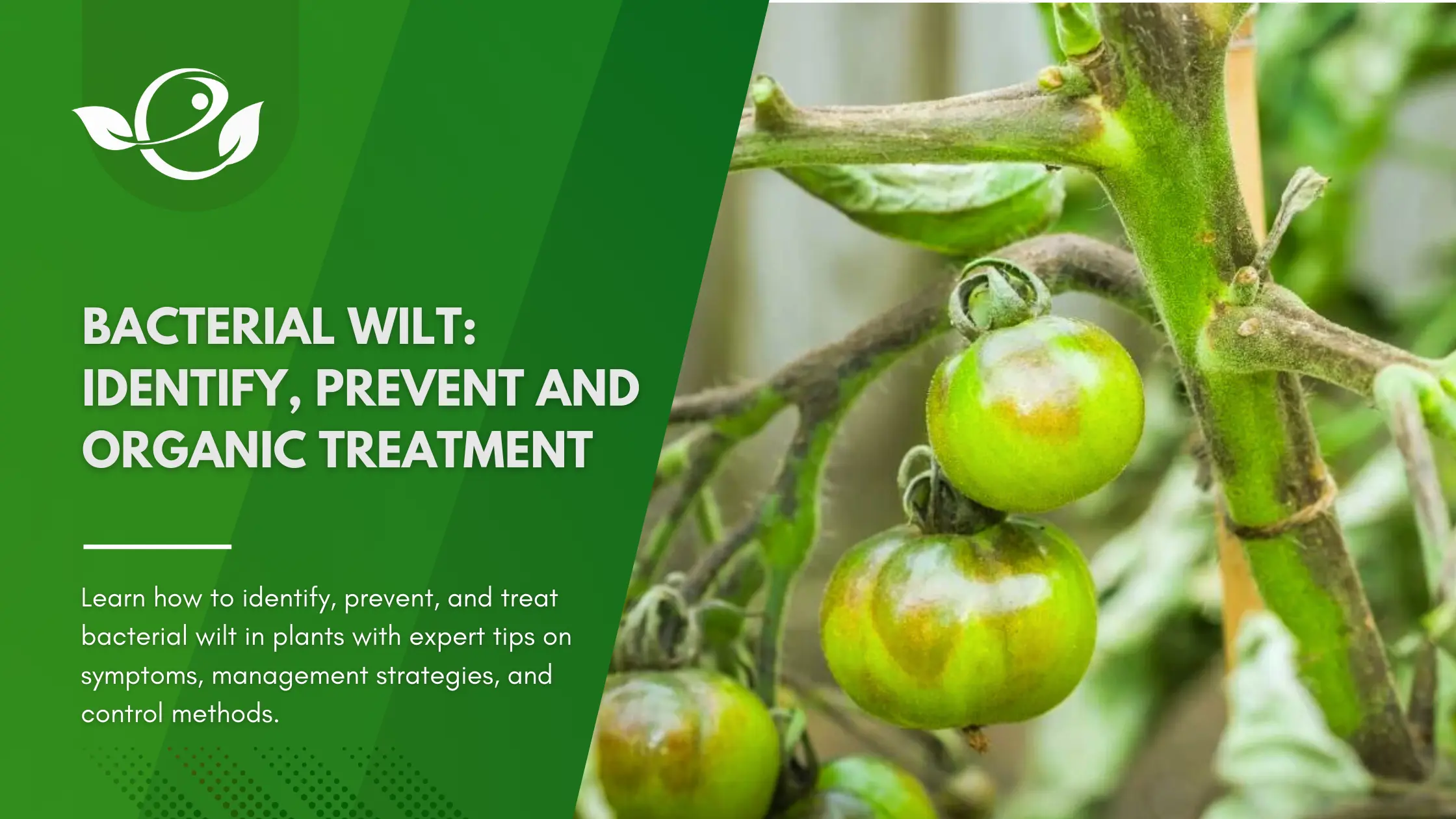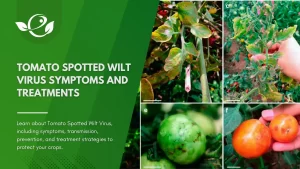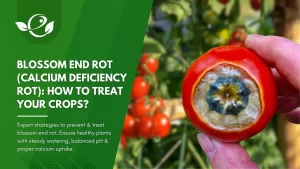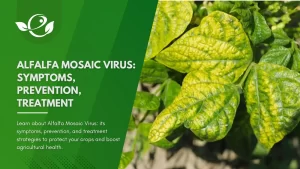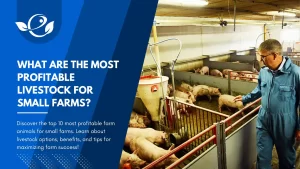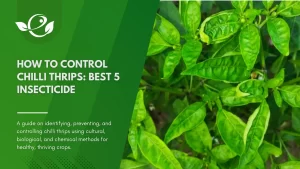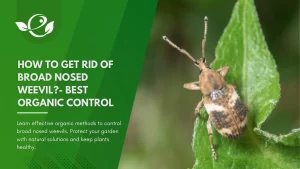Table of Contents
Bacterial wilt is more than just another plant disease; it’s a silent invader that creeps into gardens and farms, often unnoticed until it’s too late. Its impact can be devastating, reducing lush green crops to wilted remnants, and leaving farmers and gardeners alike grappling with significant losses. Imagine the frustration of seeing your thriving tomato plants, brimming with the promise of a bountiful harvest, suddenly collapse overnight. This is the harsh reality of bacterial wilt, a disease that thrives in warm, moist environments, silently spreading through soil and water, affecting a wide range of plants including tomatoes, potatoes, peppers, and even ornamental species.
But there’s hope. Understanding the life cycle, symptoms, and effective prevention and treatment strategies can make a world of difference. This comprehensive guide delves into the intricacies of bacterial wilt, equipping you with the knowledge to safeguard your plants. From identifying early symptoms to employing integrated pest management techniques, this article covers everything you need to know about battling this pernicious disease.
Understanding Bacterial Wilt
What is Bacterial Wilt?
It is a soilborne disease caused primarily by the bacterium Ralstonia solanacearum. This pathogen infects a broad spectrum of host plants, including important agricultural crops like tomatoes, potatoes, eggplants, and peppers. The disease is characterized by its ability to invade the vascular system of the plant, clogging the water-conducting vessels and ultimately leading to severe wilting and plant death.
The bacterium thrives in warm, humid conditions, making it particularly prevalent in tropical and subtropical regions. Once established in the soil, it can survive for extended periods, making eradication challenging. The economic impact of bacterial wilt is significant, especially in regions where it affects staple crops, leading to reduced yields and increased management costs.
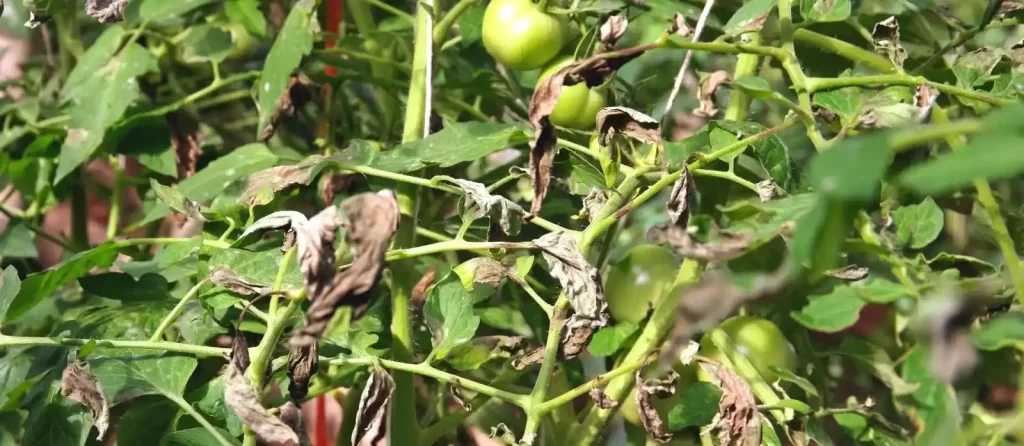
Life Cycle and Spread of Bacterial Wilt
Understanding the life cycle of Ralstonia solanacearum is crucial for effective disease management. The bacterium primarily resides in the soil and enters plants through root wounds or natural openings. It can also be spread by contaminated water, infected plant material, and even through certain insect vectors.
The bacterium can live long in soils, it can survive in plant debris or on alternative hosts. It enters the plant through wounds in the root system during the emergence of lateral roots. Elevated temperatures (from 30°C to 35°C), high humidity and soil moisture, and alkaline soil pH favor disease development. Heavy soils that can retain soil moisture for long periods are particularly vulnerable. Main alternative hosts for Ralstonia solanacearum include tomato, tobacco, plantain and banana.
Once inside the plant, the bacterium multiplies rapidly, colonizing the vascular tissue and blocking the flow of water and nutrients. This results in the characteristic wilting symptoms, which often worsen during the hottest part of the day. As the disease progresses, the plant’s overall health deteriorates, leading to yellowing, wilting, and eventual death.
Symptoms of Bacterial Wilt
Early detection of bacterial wilt is essential for managing its spread. The initial symptoms may be subtle, making them easy to overlook. Typically, the first signs are a slight wilting of the lower leaves during the hottest part of the day, which may temporarily recover overnight. As the disease progresses, wilting becomes more severe and permanent, affecting the entire plant.
Under favourable conditions, the wilting may affect the whole plant and stay permanent. The wilted leaves maintain their green color and remain attached to the stem. The roots and lower part of the stem show a dark brown discoloration. The invaded roots may rot due to infection from secondary bacteria. When cut, stems can leak a white to yellowish, milky secretion.
Key Symptoms to Look For:
- Wilting: Leaves begin to wilt during the day, recovering slightly at night in the early stages. As the disease advances, wilting becomes permanent.
- Yellowing: Affected plants may exhibit chlorosis or yellowing of leaves, often starting from the lower parts.
- Leaf Drooping: Leaves may droop and curl inward, giving the plant a lifeless appearance.
- Stem Discoloration: Internally, the vascular tissues of the stem may show brown discoloration, which is a key diagnostic feature.
- Bacterial Streaming: A quick diagnostic test involves cutting a stem and suspending it in water. If the plant is infected, a milky stream of bacterial ooze will be visible within a few minutes.

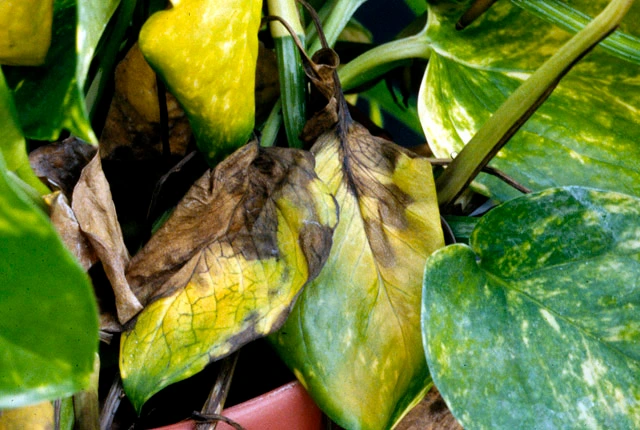
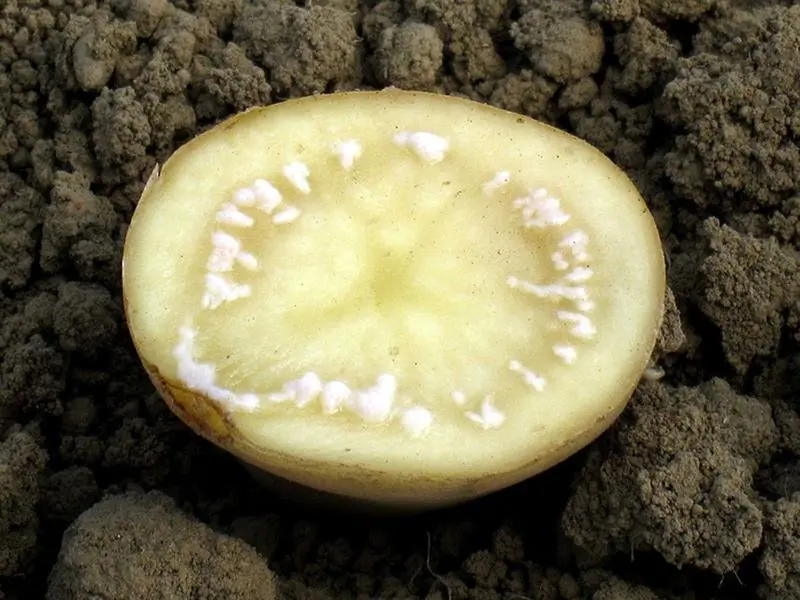
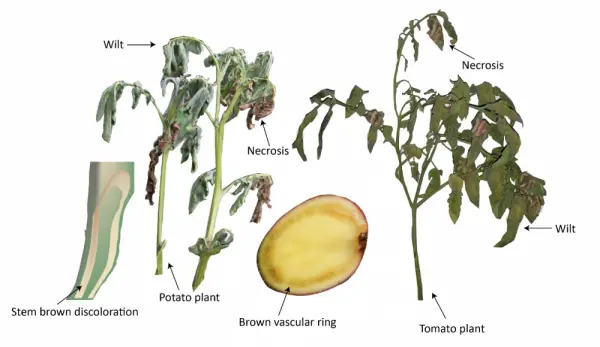
Identifying Bacterial Wilt in Plants: 3 Simple Steps
Accurate identification of bacterial wilt is crucial for implementing effective control measures. Misdiagnosis can lead to improper treatment, further aggravating the situation. Here are some steps to accurately identify this Bacterial disease:
1. Visual Inspection:
- Observe the plant for the characteristic wilting and yellowing symptoms.
- Check for leaf drooping and any visible lesions on the stems.
2. Stem Cut Test:
- Cut a small section of the stem from a wilting plant.
- Suspend the cut end in a glass of clean water and watch for bacterial streaming, a clear sign of bacterial wilt.
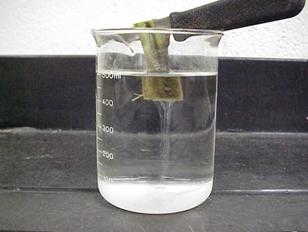
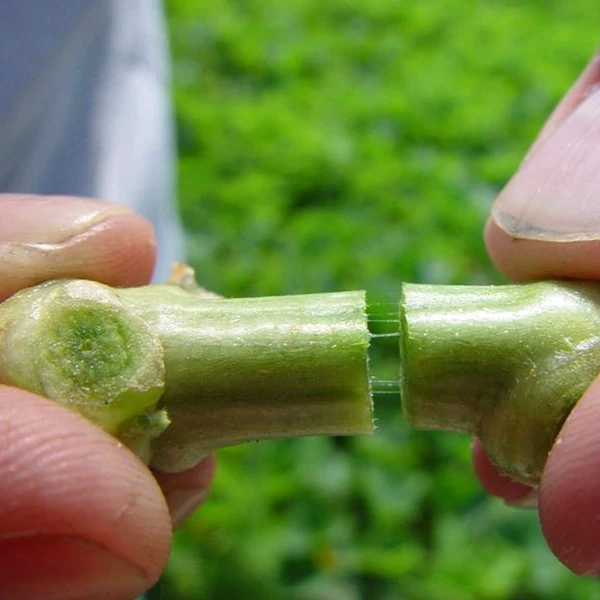
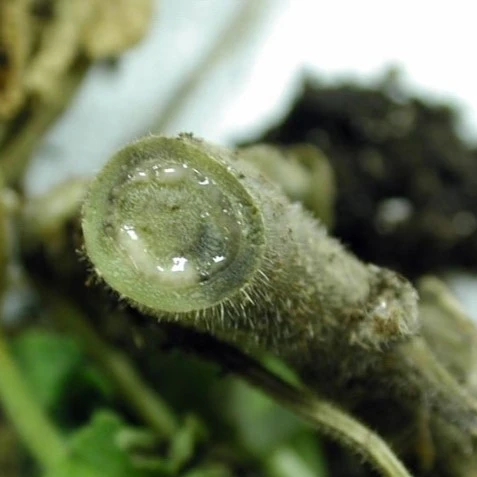
3. Laboratory Testing:
- For a more definitive diagnosis, send samples to a plant pathology lab where advanced techniques like polymerase chain reaction (PCR) can be used to identify Ralstonia solanacearum.
Prevention of Bacterial Wilt
Preventing bacterial wilt requires a multifaceted approach that combines cultural practices, soil management, and the use of resistant varieties. Since the bacterium can survive in the soil for long periods, it is essential to employ preventive measures to minimize the risk of infection.
Cultural Practices:
- Crop Rotation: Avoid planting susceptible crops in the same location for consecutive seasons. Rotate with non-host plants such as grains or legumes to reduce bacterial populations in the soil.
- Sanitation: Remove and destroy infected plants immediately to prevent the spread of bacteria to healthy plants. Clean and disinfect tools and equipment that have been in contact with infected plants.
- Water Management: Avoid overhead irrigation which can splash soil and spread bacteria. Instead, use drip irrigation to minimize leaf wetness and reduce disease spread.
Soil Management:
- Improving Drainage: Ensure fields are well-drained, as waterlogged conditions can exacerbate the spread of bacterial wilt.
- Soil Solarization: Covering soil with clear plastic in hot, sunny conditions can heat the soil to temperatures that kill bacteria.
- pH Adjustment: Adjusting the soil pH with lime can help to suppress the bacterium, as it tends to thrive in slightly acidic conditions.
Resistant Varieties:
- Planting resistant or tolerant varieties can significantly reduce the impact of bacterial wilt. Research local seed suppliers for resistant varieties suited to your region and crop type.
Avoidance Strategies:
- Plant in Uncontaminated Soil: If possible, plant in soil that has not been previously infected with bacterial wilt.
- Monitoring: Regularly monitor fields for signs of bacterial wilt, especially during favourable conditions for the bacterium.
Treatment and Control of Bacterial Wilt
Once bacterial wilt is established, it is challenging to control. However, several strategies can help manage the disease and reduce its impact.
Chemical Control:
Always consider an integrated approach with preventive measures together with biological treatments if available. Because of the soil-borne nature of the causing pathogen, the chemical treatment of the disease may be non-viable, less effective or ineffective.
- While chemical options are limited, copper-based bactericides can sometimes reduce bacterial populations. However, these are generally not highly effective against Ralstonia solanacearum.
- Antibiotic treatments, though effective in laboratory settings, are not practical or allowed for field use in most areas due to resistance concerns and regulations.
Select and apply ONLY ONE of the following products to your crops:
Product Recommendations are based on the following Active ingredients:
- Streptomycin Sulfate 90.0% SP,
- Tetracycline hydrochloride 10.0% SP
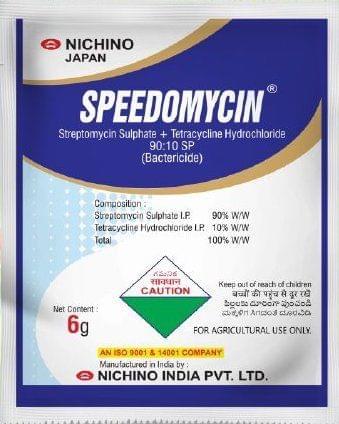
SPEEDOMYCIN by Nichino India (Nihon)
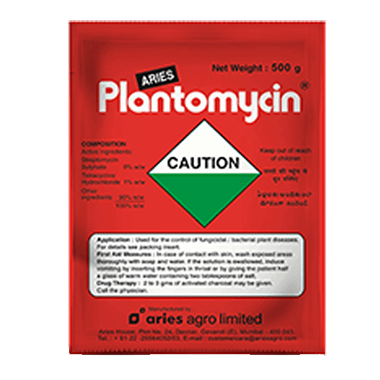
Plantomycin by Aries Agro Ltd.
Organic Control:
The incorporation of fresh plant mass (green manure) from the cruciferous family into the soil (biofumigation) can help to control the pathogen. The plant material can be macerated or chopped off before being dug into the soil, either mechanically or by hand. The plant-derived chemical Thymol has the same effect. Competitive bacteria that colonize the root systems of solanaceous plants are also effective.
Integrated Pest Management (IPM):
- IPM combines multiple strategies to manage bacterial wilt effectively. This includes crop rotation, resistant varieties, biological controls, and careful monitoring.
- Employing IPM reduces reliance on chemical controls, lowers the risk of resistance development, and promotes sustainable agricultural practices.
Soil Treatments:
- Soil Fumigation: In severe cases, soil fumigation with chemicals like methyl bromide can be used, though this is expensive and has environmental implications.
- Organic Amendments: Adding organic matter such as compost can improve soil health, enhancing its microbial diversity, which can help suppress Ralstonia solanacearum.
Conclusion
Bacterial wilt remains a formidable adversary for gardeners and farmers alike. However, with a clear understanding of its symptoms, life cycle, and spread, along with a robust prevention and treatment plan, it is possible to keep this disease at bay. The key lies in early identification, implementing preventive measures, and employing an integrated approach to disease management.
By staying vigilant and proactive, you can protect your plants from the devastating effects of bacterial wilt, ensuring healthy growth and bountiful harvests. Remember, in the battle against plant diseases, knowledge and timely action are your greatest allies.
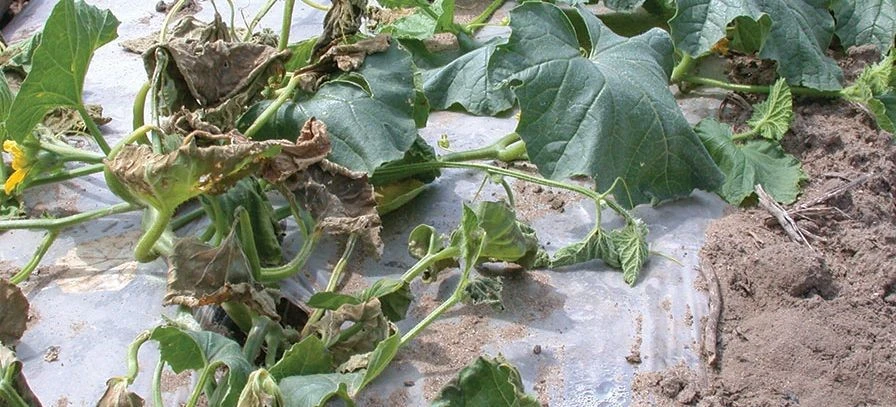
FAQs
Can bacterial wilt be completely eradicated from the soil?
Completely eradicating bacterial wilt from soil is challenging due to the bacterium’s ability to survive in the soil for extended periods. However, through crop rotation, soil solarization, and other management strategies, its impact can be significantly reduced.
Is there a chemical treatment that effectively cures bacterial wilt?
Unfortunately, there is no chemical treatment that completely cures bacterial wilt. Chemical controls like copper-based bactericides can reduce bacterial populations but are generally not very effective against Ralstonia solanacearum. The best approach involves integrated pest management practices, including biological controls, resistant varieties, and cultural methods.
How quickly does bacterial wilt spread in the field?
Bacterial wilt can spread rapidly, especially under favourable conditions of high humidity and warm temperatures. It can move quickly from infected plants to healthy ones via soil, water, and tools, making early detection and immediate action crucial.
Can bacterial wilt affect ornamental plants?
Yes, bacterial wilt can infect a range of ornamental plants, including geraniums and other popular garden species. The symptoms are similar, and the management strategies largely overlap with those used for vegetable crops.
What role do insects play in the spread of bacterial wilt?
Some insects, such as root-knot nematodes, can create entry points for Ralstonia solanacearum by damaging plant roots, although they are not direct vectors of the disease. Managing insect pests is therefore an important part of preventing bacterial wilt infections.
